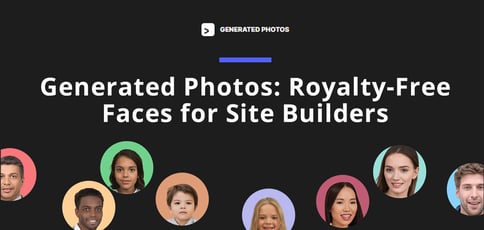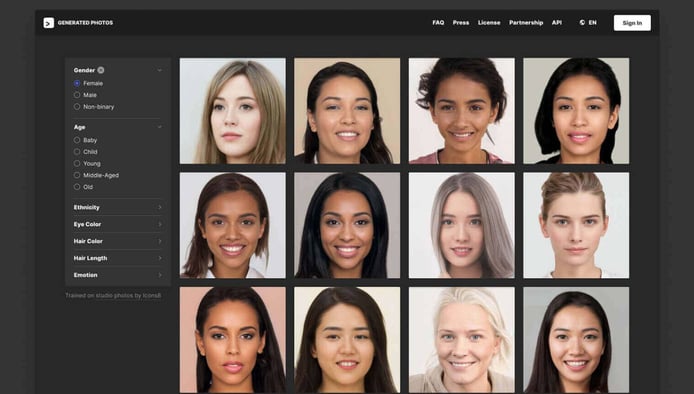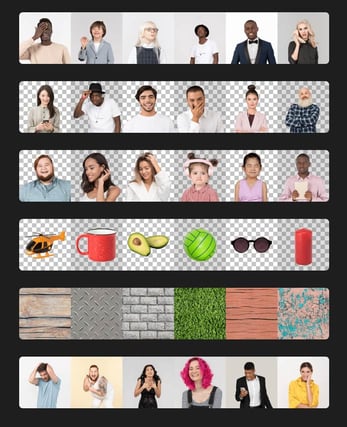
TL; DR: Generated Photos leverages AI to create synthetic images of faces that can help site builders solve cost and discovery problems related to stock photo libraries. Its photos don’t require photo shoots, and the people in them aren’t real — which is a potential regulatory bonus. The service streamlines the creative process and provides solid datasets for training AI algorithms. Up next, Generated Photos plans to expand its portfolio to include whole-body images and a more refined content diversity.
The stock image ecosystem is notorious for being hard to search and expensive to use. Several large media companies maintain vast online archives, but finding the perfect image can take plenty of patience. Depending on the vendor, pricing and licensing rules often prove arcane enough to frustrate visual designers.
Generated Photos launched in 2019 to eliminate those problems through AI-generated faces of people who look real, but don’t exist. The idea was formed in 2017, when Icons8 Photos, a collaboration between the Icons8 photo library and Photo Creator collage maker, was released as an alternative to traditional stock photos.
With consistent recomposable images, the collaboration could get over 1,000,0000 by combining just 1,000 models with 1,000 backgrounds. The idea, was to transform the field of creative photography by having people create photos instead of searching online.
“There are billions of stock photos, but you tend to see the same images everywhere, including on article landing pages,” said Alena Pashpekina, Partnerships Manager at Generated Photos. “And if you’re looking for something more specific, it can be quite challenging. If you don’t have a camera crew to shoot, that’s difficult. And if you do, it’s expensive.”

Generated Photos allows site builders to work with a variety of faces without searching stock images or paying royalty fees.
Generated Photos was the next step on that path. The project was launched 100,000 Faces, and the first dataset we created from 29,000 real photos of 69 models from Icons8 Photos.
“When we released, the whole idea was to develop generated images to transform the whole field of creative photography,” she said. “Create whatever environments, people, and objects that you need instead of searching for them.”
Today’s Generated Photos services include sorted and tagged AI-generated images, targeted datasets, and a photo anonymizer service. The company provides an API and offers several different pricing models. Its datasets include both real and synthetic faces, with a mix of emotions, poses, and demographics, to train machine-learning algorithms.
The platform eases pressure on graphic designers, site builders, and the budgets of SMBs.
Use AI-Generated Faces to Reduce Cost and Improve Diversity
When a company wants to create meaningful marketing materials or a visually appealing website, it must rely on imagery. If the company or the agency handling its site building lacks real photos of the company, it must either pay a photographer to build a dedicated library or rely heavily on stock photos. And, in the stock photo space, search accuracy is often a problem.
Most stock images are tagged only at a generic level. Thus, a search for terms like “farmer’s market” or “fruit sales” would come up with tens of thousands of images. Most of those would probably not be relevant to a company with a specific aesthetic requirement.
This problem grows when the visuals must very closely track to existing brand identity. For example, in the health insurance sector, many health plans pay very close attention to their color palettes, in part to distinguish themselves from other organizations. So stock photos with dominant blue colors may be out. The health plan would prefer stock images accented with a company’s own color palette. Adherence to brand standards matters as much for printing flyers as for website building.
A synthetic photo—using a predetermined background, color scheme, and a model that isn’t a real person—substantially improves brand appeal while minimizing litigation risk. No one in corporate marketing needs to verify whether the stock image contains a person who might sue for infringement, for example. When the models are computer-generated, the royalty costs differ, in some cases coming in at close to nothing.
“We keep getting special requests and finding users with interesting situations,” Alena said. “We recently had a couple of clients engaged in law enforcement, including a nonprofit in Australia engaged in tracking child sex offenders and we served as a training tool for officers in the U.S. They used our quick tools to make profiles of teenagers and children.” Those photo-realistic profiles aren’t of real children, so site building with those images does not put children at risk.
Today’s market also favors a greater diversity than many older stock libraries are equipped to support. With Generated Photos, a subscriber can pick precise attributes to ensure that the brand’s position on diversity is well-represented in its marketing materials.
Tech companies can also use datasets from Generated Photos to train their machine-learning algorithms to parse diverse human faces and common objects.
Train Facial Recognition Algorithms with Curated Image Libraries
Facial recognition technology suffers from a pervasive bias problem. Most of the images originally supplied to train the algorithms consisted of stock images of primarily white male faces. That means those algorithms perform poorly in the real world.
For example, they fail to correctly identify a white male face 1% of the time but fail to accurately identify a darker-skinned female face 35% of the time, according to an MIT study.

Generated Photos can help companies improve facial recognition technology with its robust AI training datasets.
Generated Photos delivers libraries of faces suitable for marketing materials, but those same images prove an ideal resource for training local machine-learning algorithms. Although most facial-recognition systems bundle hardware and software, it’s not uncommon for companies to build ML functions to determine whether a given image, like a user-supplied upload, meets expected parameters.
For example, an app might require a face photo as an avatar. With a robust ML framework trained by good data, it’s relatively straightforward for a data scientist to code a checker subroutine to report whether an uploaded image is a face or something else.
Generated Photos offers many real-life image libraries of nearly 200,000 photos with various demographic attributes. It also provides several synthetic datasets covering different emotions, ages, and ethnicities. The comprehensive synthetic facial dataset consists of more than 2.6 million photos, and the company can supply custom datasets with more than a dozen customizable parameters.
“We offer a solution for diversity issues that other datasets on the market cannot match,” Alena said. “It’s much easier for us to create balanced datasets. That way, we fight bias in facial recognition. We’re also more consistent with our metadata.”
Generated Photos includes an innovative free tool to help individuals who’d welcome an AI-generated partial clone of their own face. The Anonymizer tool accepts photo uploads and returns a synthetic face that looks similar, but not identical, to the source. The tool can help professionals who want to offer a generic impression of what they look like while retaining a degree of online privacy.
Generated Photos: Better Images with Lower Cost and Risk
Early commercial photo libraries consisted of vast seas of poorly organized and weakly tagged images. That left users choosing between a prolonged search for images to license or expensive photo shoots to build their own libraries.
With Generated Photos, subscribers can pick from a library that’s much better curated because the parameters that shaped each synthetic image are built into the product. The company offers a custom-library option for particular demographic needs.
One significant value-add for Generated Photos’s service lies in its diversity of content. A rich menu of synthetic face photos, sortable by many attributes, improves marketing materials and serves as robust training input for facial-recognition algorithms.
“Let’s say you upload a photo and change parameters, as with a face app,” Alena said. “We’ll add more parameters to tweak these images more precisely. And we’re also going to start exploring full-body integration. That is the next step for us.”
Generated Photos works well for businesses and agencies engaged in site building that need high-quality, risk-free face photos. Those same libraries serve app developers well, helping them craft responsive facial-recognition algorithms that work regardless of age, sex, race, or other attributes.
HostingAdvice.com is a free online resource that offers valuable content and comparison services to users. To keep this resource 100% free, we receive compensation from many of the offers listed on the site. Along with key review factors, this compensation may impact how and where products appear across the site (including, for example, the order in which they appear). HostingAdvice.com does not include the entire universe of available offers. Editorial opinions expressed on the site are strictly our own and are not provided, endorsed, or approved by advertisers.
Our site is committed to publishing independent, accurate content guided by strict editorial guidelines. Before articles and reviews are published on our site, they undergo a thorough review process performed by a team of independent editors and subject-matter experts to ensure the content’s accuracy, timeliness, and impartiality. Our editorial team is separate and independent of our site’s advertisers, and the opinions they express on our site are their own. To read more about our team members and their editorial backgrounds, please visit our site’s About page.



